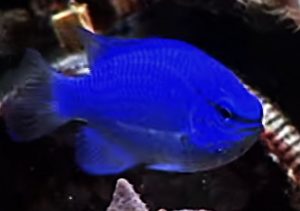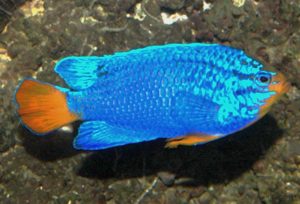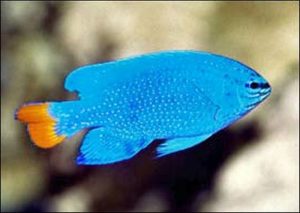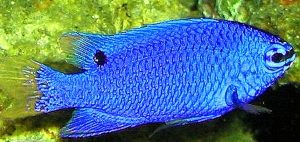The Blue Damselfish (Chrysiptera cyanea) known to tropical fish keeping enthusiasts as the Blue Devil Damselfish, Orangetail Damselfish, Orangetail Blue Damselfish, Red tail Australian Damsel, Blue Demoiselle, Sky Blue Damsel, Sapphire Devil, Devilfish, Hedleys Damselfish, Cornflower Serteant Major, and Blue Devil.
Blue Damselfish are common throughout Indo West Pacific waters along the eastern edge of the Indian Ocean, on the northern portion of the Great Barrier Reef from Western Australia to New Guinea, the Solomon, Mariana, and Caroline Islands, Indonesia, Philippines, Taiwan, and the Ryukyu Islands.
Chrysiptera cyanea have also been reported from Palau and Yap in Micronesia, New Caledonia, and Vanuatu.
The Blue Damselfish can usually be found among areas of densely growing stony corals and coral rubble in the clear, sheltered lagoons, subtidal reef flats, and protected inshore reefs at depths between 1 to 35 feet or more.
Divers have found Blue Damselfish alone, in pairs, and in small groups or “harems” around lush coral growths in the shallower waters of lagoons, sheltered bays, and the outer reefs along the coastline where they quickly retreat into the coral when threatened.
The Blue Damselfish has the ability to darken to an almost black color when threatened. After the perceived threat is gone, they return to their electric blue color in just a matter of seconds.
Blue Damselfish are a dichromatic species. From the majority of locations in their range; female Blue Damselfish are an electric blue color, lacking any yellow or orange coloration. Females collected from Japan and the Philippines are also completely blue but have a black ocellus on the lower posterior part of their dorsal fin, and nearly translucent fins.
Adult male Blue Damselfish across most of their range have a blue body but develop a yellow to yellow orange tail and a splotch of yellow orange on the nose.
Males from Japan and the Philippine Islands have a dark blue body with dark black margins on their blue fins. Females from Japan and the Philippine Islands have a bright blue body, with clear to translucent fins, and a black spot at the base of the last dorsal ray.
Male Blue Damselfish are commonly referred to by tropical fish keeping enthusiasts as Orangetail
Damselfish, Orangetail Blue Damselfish, or Blue Devil Damselfish. Specimens obtained from tropical fish stores are often juveniles that have not matured into their adult colors.
Because they pose no threat to corals, Blue Damselfish make a great addition to reef tanks. Albeit they may eat an occasional copepod, they normally ignore corals and any large or small invertebrates.
Although a 30 gallon minimum aquarium size is recommended for keeping a single Blue Damselfish or a mated pair; we recommend at least a 55 gallon capacity tank, with a sand or fine coraline substrate, plenty of mature live rock arranged into overhangs, crevices, and caves for hiding among, and substantial areas of free space for swimming.
Blue Damselfish can also be housed in a community FOLR tank as one male and several females, as several juveniles, with other damselfish species, or in combination with other semi aggressive species like triggerfish, dwarf angels, dottybacks, puffers, larger angelfish, and species that can hold their own.
Keeping several juveniles, or a lone male with several females in a 30 to 55 gallon tank can be successful, provided plenty of mature live rock arranged into hiding places is available, and the fish are introduced last and at the same time.
A minimum of a 100 gallon aquarium is recommended for a mixed, semi aggressive, reef or FOLR community tank.
Because Blue Damsels will always develop their own territory and defend it against any fish in the vicinity; its best NOT to house them with the following less aggressive species unless the aquarium is at least 100 gallons in capacity and has plenty of aged live rock for hiding among: Centropyge angelfish, small juvenile butterflyfish, peaceful gobies, blennies, cardinalfish, firefish, dartfish, assessors, fairy wrassesr, mandarins, seahorses, pipefish, anthias, clownfish, etc.
Chrysiptera cyanea are compatible with the following fish and corals: Moderately aggressive fish, dottybacks, 6-line & 8-line wrasse, damselfish, tangs, large angels, large wrasses, Anemones, Mushroom Anemones – Corallimorphs, LPS corals, SPS corals, Gorgonians, Sea Fans, Leather Corals, Soft Corals (tree corals and Xenias), Star Polyps, Organ Pipe Corals, Sponges, Tunicates, Zoanthids, Button Polyps, Sea Mats, Decorative Shrimp, Crabs, Snails, Starfish, Feather Dusters, Bristle Worms, Flatworms, Clams, Scallops, Oysters, Amphipods, Copepods, and mini Brittle Stars.
The Blue Damselfish is a substrate spawner that will readily spawn in reef tanks. They have been bred in an aquarium environment, however, the eggs and larvae are quite small, subject to predation in the tank, and the fry are extremely difficult to rear.
To entice a female, the males prepare a nesting site in their territory with some smooth rubble or a piece of clam shell near the entrance. About a day prior to spawning, each female will visit all the males in her colony to search for the fittest male to mate with. When she decides on a potential mate, she will stop swimming, face upwards and flash a light ring around each eye to solicit inspection of the nest site. The male then initiates a courting dance trying to impress the female. The females are picky and will travel from nest site to nest site to review several potential mates before selecting one.
Early the next morning, the female will immediately spawn with the largest male who has put on the best dance. If another female decided on the same male, she will wait at the entrance to the nesting area for her turn to spawn. Several females have been seen waiting at one nest site to spawn with the same dominant male.
Spawning itself is similar to other substrate spawners; the female lays up to 20,000 tiny oval adhesive eggs on the smooth walls and ceiling of the structure. The male in between batches quickly fertilizes them and will aggressively and fearlessly guard the eggs from intruders until they hatch out in 3 to 7 days. Note that brittle stars, serpent stars, wrasses, and crabs will eagerly eat the eggs and fry of Blue Damselfish.
The hatched larvae drift away with the current as plankton, feeding on the other zooplankton and phytoplankton for up to 50 days before settling to the bottom. Damselfish can take from 2 to 3 years to mature into adults.
Because of the inexpensiveness of this species, the vast majority of Chrysiptera cyanea are wild caught for the aquarium hobby.
In their natural habitat, Blue Damselfish are omnivores that feed on plankton, algae, and small benthic crustaceans. In an aquarium environment with plenty of live rock; they thrive on a diet of frozen omnivore and herbivore preparations, marine algae, brine shrimp, Krill, Mysis
, omnivore flakes, and Zooplankton.
Blue Damselfish (Chrysiptera cyanea) are probably the best selling marine species in the United States. They are extremely hardy, inexpensive, and readily available to tropical fish keeping enthusiasts from tropical fish shops and a multitude of online sources at approximate purchase sizes of 1″ to 2″.
Although many beginning hobbyists use them to cycle their tanks; we do not condone this practice. Its much easier and faster to cycle a marine aquarium with mature live rock.
Minimum Tank Size: 55 gallons for single or pair/ 100 gallons for community
Aquarium Type: Reef, FOLR
Care Level: Easy
Temperament: Aggressive
Aquarium Hardiness: Very Hardy
Water Conditions: 72-84°F, dKH 8 to 12 , pH 8.1 – 8.4, sg 1.020-1.025
Max. Size: 3.4″
Color Form: Blue, Orange
Diet: Omnivore
Compatibility: Reef
Origin: Indo West Pacific waters
Family: Pomacanthidae
Lifespan: 5 years
Aquarist Experience Level: Beginner






One Response to “Blue Damselfish (Chrysiptera cyanea)”
Trackbacks/Pingbacks
[…] their closely related cousins Chrysiptera cyanea, the Fiji Blue Devil Damselfish (Chrysiptera taupou) is sexually dimorphic and sexes are easily […]